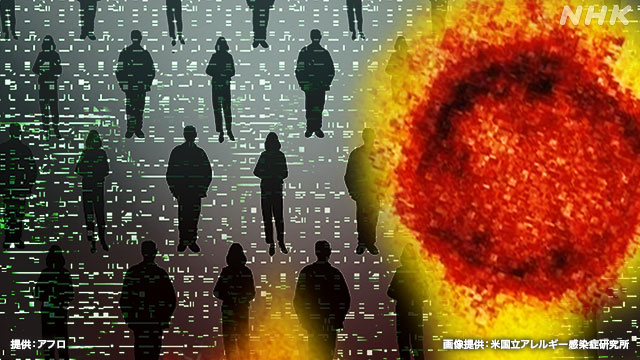The government subcommittee has four stages that indicate the infection status, as indicators for determining which stage it is in:
▼ "Bed tightness",
▼ "Number of medical treatments",
▼ "Positive rate of PCR test" ,
▼ "Number of newly infected people",
▼ "Comparison of the number of infected people in the last week and the previous week",
▼ "Percentage of people whose infection route is unknown" are listed.
According to the Cabinet Secretariat, as of the 18th of this month, the 11 prefectures that declared a state of emergency have exceeded the most serious "Stage 4" guideline in a number of indicators.
1 The tightness of the bed
First of all, the tightness of the bed.
As a guide, the bed usage rate is 20% for stage 3 and 50% for stage 4.
The usage rate of the entire sickbed is
▼ 75.3% in Tokyo,
▼ 63.9% in Saitama
,
▼
55.1% in Chiba
,
▼
48.4% in Kanagawa
,
▼
63.4% in Tochigi
,
▼
64.4% in Aichi,
▼ Gifu 64.5% in prefecture,
▼ 75.7% in Osaka prefecture,
▼ 78.2% in Hyogo prefecture,
▼ 36.4% in Kyoto prefecture,
▼ 58.0% in Fukuoka prefecture.
Of these, the beds for the severely ill are
▼ 100% in Tokyo,
▼ 39.5% in Saitama
,
▼
22.8% in Chiba
,
▼
55.5% in Kanagawa
,
▼
45.7% in Tochigi
,
▼
47.9% in Aichi,
▼ Gifu prefecture has 37.3%,
▼ Osaka prefecture has 69.8%,
▼ Hyogo prefecture has 62.5%,
▼ Kyoto prefecture has 40.7%, and
▼ Fukuoka prefecture has 26.4%.
2 Number of recuperators
Next, the number of recuperators is about 100,000 people, 15 in stage 3 and 25 in stage 4.
▼ 149.3 people in Tokyo,
▼ 88.1 people in Saitama prefecture,
▼ 98.1 people in Chiba prefecture,
▼ 68.6 people in Kanagawa prefecture,
▼ 71.2 people in Tochigi prefecture,
▼ 47.0 people in Aichi prefecture
,
▼
32.2 people in Gifu prefecture,
▼ There are 73.5 people in Osaka
prefecture, 37.5 people in Hyogo prefecture
, 54.9 people in Kyoto prefecture,
and 74.7 people in Fukuoka prefecture.
3 Test positive rate
This is the positive rate for PCR tests in the last week.
The standard value is 10% for both stage 3 and stage 4.
▼ 11.7% in Tokyo,
▼ 8.4% in Saitama
,
▼
13.4% in Chiba
,
▼
19.9% in Kanagawa
,
▼
7.6% in Tochigi
,
▼
8.9% in Aichi
,
▼
6.6% in Gifu,
▼ It is 8.8% in Osaka
prefecture, 13.0% in Hyogo prefecture
, 10.5% in Kyoto prefecture,
and 9.8% in Fukuoka prefecture.
4 Number of newly infected people
The standard number of newly infected people per 100,000 population is 15 in stage 3 and 25 in stage 4.
▼ 75.5 people in Tokyo,
▼ 40.0 people in Saitama prefecture,
▼ 49.9 people in Chiba prefecture,
▼ 66.4 people in Kanagawa prefecture,
▼ 29.0 people in Tochigi prefecture,
▼ 23.9 people in Aichi prefecture
,
▼
23.5 people in Gifu prefecture,
▼ There are 40.8 people in Osaka
prefecture, 31.4 people in Hyogo prefecture
, 35.2 people in Kyoto prefecture,
and 40.5 people in Fukuoka prefecture.
5 Comparison of the number of newly infected people in the last week and the previous week
When comparing the number of infected people in the last week and the previous week, the standard value is 1 times for both stage 3 and stage 4.
▼ 0.8 times in Tokyo,
▼ 1.0 times in Saitama prefecture,
▼ 1.2 times in Chiba prefecture
,
▼ 1.2 times in
Kanagawa prefecture,
▼ 0.6 times in Tochigi prefecture,
▼ 0.8 times in Aichi prefecture,
▼
0.8 times in
Gifu prefecture,
▼ It is 0.9 times in Osaka
prefecture, 1.0 times in Hyogo prefecture, 1.0 times in
Kyoto prefecture, and 1.0 times in
Fukuoka prefecture.
6 Percentage of people with unknown infection route
Finally, the percentage of people whose infection route is unknown.
The standard value is 50% for both stage 3 and stage 4.
▼ 56.6% in Tokyo,
▼ 39.7% in Saitama
,
▼
82.9% in Chiba
,
▼
55.9% in Kanagawa
,
▼
34.5% in Tochigi
,
▼
42.2% in Aichi
,
▼
21.7% in Gifu,
▼ It was 46.6% in Osaka
prefecture, 37.7% in Hyogo prefecture
, 29.2% in Kyoto prefecture,
and 42.0% in Fukuoka prefecture.

